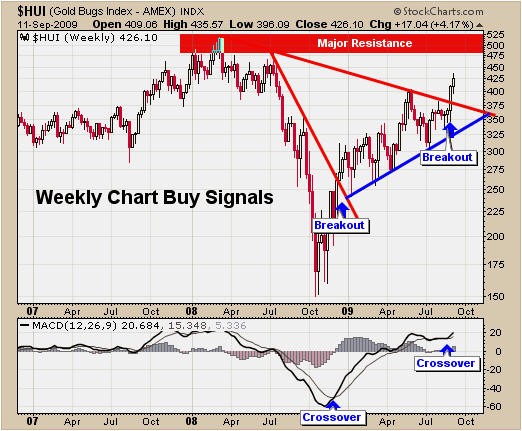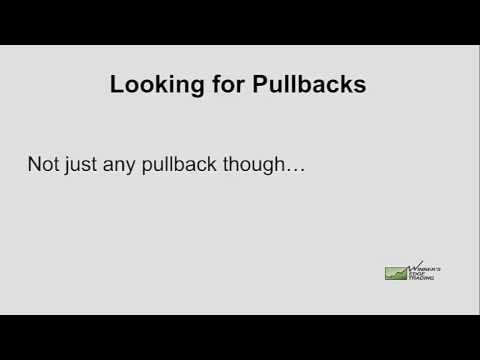Buying and selling gold using momentum indicators for stronger returns
Post on: 2 Июль, 2015 No Comment

If you trade gold and gold stocks, timing purchases and sales using certain key momentum indicators should sharply increase your returns. Retrospective analysis.
Lorimer Wilson | 22 December 2011 04:18
Assessing the relative levels of greed and fear in the market at a given point in time is an effective way of timing the market. This article outlines the 6 most popular momentum indicators and concludes that trading gold using just 3 of the indicators would have generated an annual return of 39.6% compared to the YTD buy-and-hold return of only about 13%! Let me explain how, why and where they should be used and examine their specific application relative to the price movements in gold and the HUI.
Securities ebb and flow, surge and retreat, and such action is measured by oscillators which are powerful leading indicators of the securitys immediate direction and its speed and are most useful, and issue the most valid trading signals, when their readings diverge from prices.
Bullish divergences occur when prices fall to a new low while an oscillator fails to reach a new low. This situation demonstrates that bears are losing power, and that the bulls are ready to control the market for the stock or index again and such divergence often marks the end of a downtrend.
Bearish divergences signify up-trends, when prices rally to a new high while the oscillator refuses to reach a new peak. In this situation, bulls are losing their grip on the security, prices are rising only as a result of inertia, and the bears are ready to take control again.
There are a number of different approaches to this concept, as follows:
1. Stochastic Oscillator (SO)
is a momentum indicator that compares a securitys closing price to its price range over a given time.
The theory behind this indicator is that in an upward-trending market, prices tend to close near their high, and during a downward-trending market, prices tend to close near their low.
There are two components to the SO: the %K which is the main line indicating the number of time periods (usually 14), and the %D which is a three-period moving average of the %K. Buy/sell signals occur when the %K crosses above/below the %D.
A %K result of 70 (or 30), for example, is interpreted to mean that the price of the security closed above 70% (or below 30%) of all prior closing prices that have occurred over the past 14 days and assumes that the securitys price will trade at the top (or at the bottom) of the range in a major uptrend (or downtrend).
A move above 80 suggests that the security is overbought and therefore should be sold while a move below 20 suggests that the stock or index is oversold and, as such, is a buying signal.
The SO, which ignores market jolts, is an ideal companion to the MACD to provide an enhanced and more effective trading experience. Using the two together gives traders an opportunity to hold out for a better entry point on an up-trending security or to be more sure that any down-trend is truly reversing itself when bottom-fishing for long-term holds.
However, on the downside, because the stock or index generally takes a longer time to line up in the best buying position, the actual trading of the security occurs less frequently, so you may need a larger basket of stocks to watch.
2. Relative Strength Index (RSI)
is a momentum indicator that compares the magnitude of recent gains in price to recent losses in an attempt to determine overbought and oversold conditions of a security.
The RSI, on a scale of 0-100, indicates that a stock is overbought when it is over 70 and oversold when it is below 30.
Because large surges and drops in the price of a security will create false buy or sell signals the RSI works best when it is used in conjunction with short-term moving average crossovers such as the Stochastic Oscillator to confirm a directional shift.
3. StochRSI
is created by applying the Stochastic Oscillator to the Relative Strength Index values rather than standard price data thereby giving the trader a better idea of whether the current RSI value is overbought or oversold a measure that becomes specifically useful when the RSI value is confined between its signal levels of 30 and 70.
20lorimer%201.jpg?0f5ae5 /%
If you had used the above 3 indicators as your guide to buy and sell physical gold throughout 2011 you would have:
- bought gold on Feb. 1st at approx. $1,325 and sold out on April 21st just prior to the Good Friday/Easter long weekend at approx. $1,500 for a profit of $175 or 13%
- bought back in at approx. $1,500 on July 5th after the long weekend and sold out at $1,850 or so on September 6th immediately after the Labor/Labour Day long weekend for a tidy profit of approx. $350 or 23%
The above 3 indicators do not yet suggest that you get back into gold yet. Nevertheless, trading gold using the above 3 indicators would have generated a profit of $525 for an annual return on your gold investment of 39.6% over just 132 days compared to a YTD buy-and-hold return of only about 13%!
Now lets look at a chart for the same time period using the TRIX, CCI and ROC momentum indicators and see what they reveal:
20lorimer%202.jpg?0f5ae5 /%

4. TRIX
is a momentum indicator that displays the percent rate-of-change of a triple exponentially smoothed moving average of a securitys closing price.
TRIX is designed to filter out security movements that are insignificant to the larger trend of the security. The user selects a number of periods (such as 15) with which to create the moving average, and those cycles that are shorter than that are filtered out.
TRIX is also a leading indicator and can be used to anticipate turning points in a trend through its divergence with the securitys price.
5. Commodity Channel Index (CCI)
is an oscillator which quantifies the relationship between the securitys price, a moving average of the securitys price, and normal deviations from that average to determine when a security has been overbought or oversold.
The CCI, when used in conjunction with other oscillators, can be a valuable tool to identify potential peaks and valleys in the securitys price, and thus provide investors with reasonable evidence to estimate changes in the direction of price movement of the security.
6. Price Rate of Change (ROC)
measures the percentage rate of change, indicating the strength of the momentum, between the most recent price and the price over x periods (the narrower the better) thereby identifying bullish or bearish divergences.
The ROC is able to forecasts sooner than almost any other indicator an upcoming reversal of a trend and whether or not a securitys price action is created by those over-buying or over-selling it. A number other than zero can be used to indicate an increase in upward momentum and a number less than zero to indicate an increase in selling pressure.
An analysis of the movement in the price of gold in 2011 using the TRIX, CCI and ROC indicators, however, would not have been nearly as effective in identifying entry and exit points to the extent that the STO, RSI and StochRSI indicators do.
PRECIOUS METALS STOCKS
A look at the 1 year chart for the HUI Index below using the Full STO, RSI and StochRSI shows that these momentum indicators are also very useful in capturing points in time to buy and sell large cap gold and silver stocks and their associated warrants where available.
20lorimer%203.jpg?0f5ae5 /%
If you had used the above 3 indicators as your guide as to when to buy and sell a basket of large-cap gold and silver mining and royalty stream company stocks throughout 2011 you would have:
- bought in around Jan. 21st and sold out around April 8th for a return of approx. 13%
- bought back in the week of May15th and sold out around Sept. 8th for a return of approx. 14%
As with gold the above 3 indicators do not yet suggest that you get back into the gold and silver mining stocks yet. Nevertheless, trading such stocks using the above 3 indicators, and the HUI as a proxy, would have generated an annual return on your investment of approx. 27% over just 190 days compared to a YTD buy-and-hold return of about -11% !
So there you have it an extensive and in-depth assessment of how to evaluate the momentum impacting your securities of interest. The next time you analyze an asset you will be in a better position to determine which direction the asset is trending and what the appropriate dates are throughout the year to buy and sell the security.
Lorimer Wilson is editor of www.munKNEE.com and a frequent contributor to www.PreciousMetalsWarrants.com














